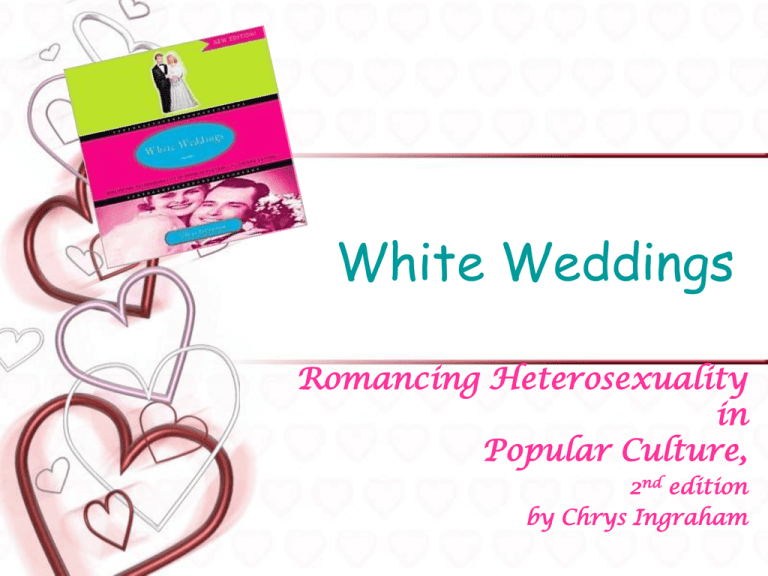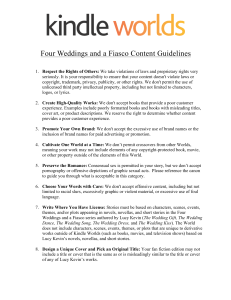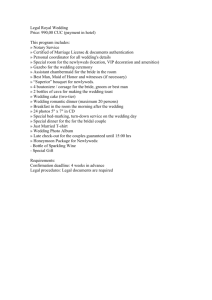
White Weddings
Romancing Heterosexuality
in
Popular Culture,
2nd edition
by Chrys Ingraham
The Wedding Industrial Complex
• Referred to by Wall Street analysts as
“recession-proof,” the wedding industry
has reached such proportions that it can
be more accurately described as a
wedding industrial complex.
• This structure reflects the close
association among weddings, the
transnational wedding industry, labor,
global economics, marriage, the state,
finance, religion, media, the world wide
web, and popular culture.
The Wedding Industrial Complex
Popular Culture
Media
Religion
Marriage
State
White Weddings
The World Wide Web
Labor
Finance
The Transnational Wedding Industry
Global Economy
The Transnational Wedding Industry
• Capitalism, by definition, requires expanding markets
and cheaper production costs in order to increase
profits. To this end, producers must locate new
consumers either by creating new desires or by
expanding into previously untapped regions or
markets.
• Globalization describes the processes by which
production, distribution, and markets have made use of
global relationships and resources.
• What makes the wedding industry transnational? The
industry is based in the U.S. but the majority of goods
used by the industry are either outsourced to
producers in other countries or manufactured by
workers and use resources from (mostly developing)
countries at a significantly lower cost.
The Transnational Wedding Industry
These lower costs include:
• Paying workers substandard wages
• Child labor
• Sexual abuse and slavery
• Exposure to toxins
• Excessive work hours
The consequences of these practices include:
• Cultural, social, economic, and political
changes
• Changes in migratory patterns resulting
from poverty and production changes
• Increased struggles over immigration and
immigration laws
The Transnational Wedding Industry
• According to industry estimates, the average
wedding in the United States costs $27,852,
with some regional variations.
• Considered in relation to what Americans
earn, the cost of the average wedding
represents 62.3 percent of the median
earnings of a white family and 92 percent for
black and Hispanic families.
• The fact that 40 percent of Americans earn
less than $25,000 per year means the average
cost of a wedding approximates a year’s
earnings for many Americans.
The Relative Cost of a White
Wedding
Given the extent to which the wedding industry has become
globalized, and that nearly one half of the world lives on
$2 per day, consider what else the average cost of a white
wedding in the U.S. would buy in those locations where many
wedding products are made:
WHAT $27,852 WILL BUY WHERE WEDDING PRODUCTS ARE
PRODUCED:
• Food for 3000 people in South Asia.
• Cost to build 12 wells for people in Southeast Asia, Africa,
and Latin America.
• Medicine for 10,000 children for one year in Africa.
• At wages of 12 cents per hour to sew wedding gowns,
the cost to pay 111 workers for one year.
• At wages of $28 per week for mining diamonds in South Africa,
the cost to pay 19 workers for one year.
Targets of the Wedding
Industry
Who marries?
• The average age for brides had risen from 20 in
1960 to 25; for grooms from 23 to 26.8 years.
(US Census 2000)
• By 2006, the average age increased to 27 for
brides and 29 for grooms.
• According to the wedding industry, today’s
newlyweds are also more likely to be dual-earner
couples, with 83% of brides and 89% of grooms
working with a combined income 1/3 greater than
the median household income, at $65,076.
• The total number of marriages and remarriages
declined from 2,342,000 in 1996 to 2,253,750 by
2006, and the marriage rate has decreased from
8.8 to 7.8 per 1000 persons.
(Bride’s 1996; U.S. Bureau of the Census 1996)
Targets of the Wedding
Industry
What is the remarriage market?
• Includes people who want to reaffirm their
vows;
• Growing population of widowed seniors who
are remarrying
• As of 2005, 50% of all marriages are
remarriages
for at least one of the participants (CDC, National Vital
Statistics Reports, 2003.)
• Even though remarriage weddings tend to be
smaller, the wedding industry estimates that
they represent 40%of their revenues
Targets of the Wedding
Industry
The effects of race and class on wedding
consumption:
• Most state and industry analysts have
overlooked these effects.
• They have focused mainly on the white
wedding market, especially the middle-toupper middle class whites.
• For example, the 78% marriage rate cited in
wedding industry and census data is
primarily applicable to whites and Asians and
is significantly lower for Hispanics (67
percent) and even lower yet for blacks (42
percent).
The White Wedding Market
Table 2.6 Socioeconomics Factors
Median earnings
Poverty rates_ College degree
BLACK
$30,134
24.7%
17.6%
HISPANIC
$34,241
21.9%
12.1%
WHITE
$48,977
8.6%
30.6%
ASIAN
$57,518
9.8%
49.4%
SOURCE: U.S. Census 2006
The White Wedding Market
Next, consider our assumptions as Americans about
marriage and weddings:
1. We assume that most people not only desire
marriage but that most people do, eventually,
marry.
Fact: the national rate of marriage in the U.S. has
declined by about 30% in the past 20 years to 52%
of the nation's estimated 106 million households.
2. We assume there are few differences in marriage
patterns across race and social class.
Fact: As the charts on the previous slides
illustrate, there are significant differences across
race and social class.
Social Inequality and Marriage
• Marriage frequency drops dramatically
as its economic and material benefits
decrease.
• While middle class women no longer
“need” to marry for financial security,
poor women do not participate in part
because it puts them at greater risk
economically.
Social Inequality and Weddings
• Contrasted against the rising
expenditures on weddings, it is possible
to conclude that the primary target of the
wedding industry is people who place
higher up on the socioeconomic scale.
• The lower one’s socioeconomic level, the
less likely they are to marry and the less
they will pay for a wedding.
• Considering weddings from an economic
standpoint, it is possible to conclude that
the white wedding industry targets
privileged whites more prominently than
any other group.
“Marriage is for white people.”
• The wedding industry and wedding
marketers are aware that the
combined earnings of black or
Hispanic newlyweds is usually
significantly lower than those of
whites and are likely to remain lower
throughout the course of the marriage
(which is also shorter).
• Wedding marketers know that white
middle-class women are more likely to
consume wedding products than any
other group.
“Marriage is for white people.”
• Even within the advertising industry there
is considerable evidence of racial
segregation and of institutional racism
affecting who is hired and what images and
strategies are used in wedding advertising.
• Throughout the wedding industry, images
of white women and couples are pervasive
and set both a race and class standard for
who marries and who has a white wedding.
Same-sex wedding market
• Significant market forces invested in
same-sex marriage debates.
• The transnational wedding industry,
already expanding its global market
share, stands to make substantial gains
if same-sex marriage becomes legal in
the U.S.
• In California, Massachusetts, Vermont,
Canada, England, the Netherlands, and
Spain where same-sex marriage is legal,
the wedding industry is already reaping
benefits.
The Future Wedding Market
Factors causing changes and increases in
the wedding market:
• Changes in earning potential and buying
power of people from historically
underrepresented groups.
• The growth of the internet for advancing
the interests of the wedding industry.
• Increases in transnational consumption
and production, especial as a result of
the internet and globalization.
• Destination weddings
The Primary Wedding Market
There are 3 levels of the transnational
wedding market: primary, secondary,
and tertiary.
The Primary Wedding Market
• Markets directly to people planning a
wedding.
• With revenues estimated as upwards of
$120 billion, the primary wedding
market is the equivalent of a major
multinational corporation.
The Secondary Wedding Market:
Businesses interested in developing a
future clientele and targeting
newlyweds indirectly.
Made up of companies using white
weddings to sell products indirectly.
Examples include everything from
life insurance to wedding toys to
Viagra.
Strategies to secure future wedding
product consumption.
What has this child learned about
beauty?
DISNEY
“When you wish upon a star, makes no difference
who you are. When you wish upon a star your
dreams come true.” (Disney theme song)
• One of the most dramatic examples in the
wedding-industrial complex is the Walt Disney Co.
• They are involved in both the primary wedding
market and secondary wedding market.
• They play a powerful role in securing future
consumers by catering directly to both children
and adults through film, television, theme parks,
sports franchises, publishing companies, and new
interactive media outlets.
• Disney is the world’s second-largest media
conglomerate with annual revenues exceeding $54
billion, 133,000 employees, 10 collective
bargaining agreements, 32 unions, and holdings
that are extremely diverse.
The Tertiary Wedding Market
• The tertiary wedding market is made up of
those companies that have little or no
relationship to the wedding market or to
newlyweds but make use of wedding
imagery and the heterosexual imaginary to
capture the imaginations of potential
consumers.
• White weddings appear in a vast array of
advertising for products such as Buick,
One-A-Day Vitamins, Pepto Bismol, Esteé
Lauder perfume, Colgate-Palmolive
products, General Electric, McDonald’s,
Tylenol, Bayer Aspirin, Pepsi, Ford,
Chevrolet, Toyota, Verizon, and Midas
Muffler, to name a few.
The State
• The state plays a major role in affecting
how we think about and engage in the
practice of wedding.
• In regulating marriage materially via civil
law, the state injects its presence into
the wedding ceremony through
licensing practices and fees,
establishing who is legally “qualified” to
officiate a wedding, and charges for
blood tests and name changes.
• The state also protects its interests
through miscegenation, domestic
relations, and other laws regarding what
constitutes legitimate marriage.
The State
• The state plays another significant role
and one even less obvious than any
previously mentioned. Through free trade
agreements such as the North American
Free Trade Agreement (NAFTA)
• The state creates the conditions by
which offshore labor practices are
undertaken in the manufacturing of such
products as wedding gowns, gifts, and
wedding toys.
• And the state features in the travel
industry to the extent that it regulates
tourism particularly in conjunction with
transnational corporations and national
security interests.
The State
• In 1997 the U.S. Congress voted
overwhelmingly to pass the Defense of
Marriage Act (DOMA).
• With this act they changed the role of the
federal government in defining
“marriage” as a “legal union between
one man and one woman as husband
and wife”—usually a right reserved for
states—and prohibited the legalization of
same-sex marriage for federal purposes
and allowing states to ignore a same-sex
marriage from another state.
The State
• “Although the marriage contract is
governed by state law, the federal
government uses marital status as the
qualification for more than 1,096 federally
registered rights and responsibilities.”
• With the passage of this law, the U.S.
government essentially asserted that state
and federal rights and responsibilities
connected to legal marriage be denied
anyone who is not married—singles,
lesbians, gay men, cohabitating
heterosexuals, siblings living together,
etc.
The State
• In preparation for passage of this bill, the U.S.
Government Accounting Office (GAO)
identified all federal laws in which marital
status is a factor. They found thirteen
categories: Social Security (which includes
related programs, housing, and food stamps);
veterans’ benefits; taxation; civilian and
military benefits; employment benefits;
immigration and naturalization laws; Indians;
trade, commerce, and intellectual property;
financial disclosure and conflict of interest;
crimes and family violence; loans, guarantees,
and payments in agriculture; federal natural
resources and related laws; and miscellaneous
laws.
• All of these benefits are attached to one’s
marital status rather than one’s citizenship.
Religion
• Religions vary in the meaning they
attach to the wedding, but all
reserve the right to require certain
practices and beliefs regarding the
wedding ceremony as well as the
institution of marriage.
• While religions interact with the
state in legalizing marriage, their
power rests in legitimizing
marriage through moral teachings.
Religion
• The wedding becomes a site for the
ritual enactment of religious
doctrine
• It shores up the stake the church
has in a patriarchal social order
and in heterosexual marriage
• This investment ensures a
heterogendered division of labor
and women’s historical function as
the property of men.
Mass Media
• The role of the mass media is
primarily ideological and comprised
of what sociologist Howard Becker
calls “consciousness industries.”
• Their task is to provide the public with
information and materials that help
shape how we view the world,
ourselves, and the values we live by.
• They provide the symbols, myths,
images, and ideas by which we
constitute dominant culture.
Mass Media
• Mass media are used by the privileged to define or
legitimize entitlements by producing certain belief
systems, based largely on myths and stereotypes.
• The staging of weddings in television shows,
weekly reporting on weddings in the press,
magazine reports on celebrity weddings,
advertising, and popular adult and children’s
movies with wedding themes or weddings inserted
all work together to teach us how to think about
weddings, marriage, heterosexuality, race, gender,
and labor.
• Through the application of the heterosexual
imaginary, the media cloak most representations
of weddings in signifiers of romance, purity,
morality, promise, affluence or accumulation, and
whiteness.
Conclusion
• The contemporary white wedding under
transnational capitalism is, in effect, a massmarketed, homogeneous, assembly-line
production with little resemblance to the utopian
vision many participants hold.
• The engine driving the wedding market has
mostly to do with the romancing of
heterosexuality in the interests of capitalism.
• The social relations at stake—love, community,
commitment, and family—become alienated from
the production of the wedding spectacle, while
practices reinforcing a heterogendered and
globalized racial division of labor, white
supremacy, the private sphere as women’s work,
and women as property are reinforced.






